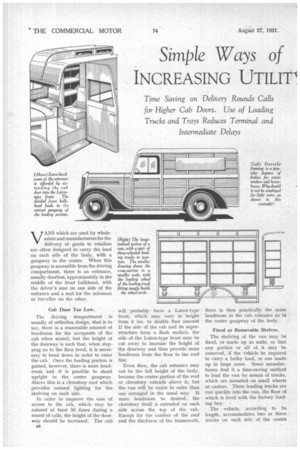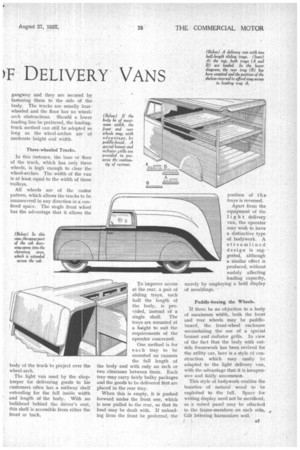Simple Ways of
Page 40

Page 41

If you've noticed an error in this article please click here to report it so we can fix it.
INCREASING UTILITI
)F DELIVERY VANS VANS which are used by wholesalers and manufacturers for the delivery of goods to retailers are often designed to carry the load on each side of the body, with a gangway in the centre. When this gangway is accessible from the driving compartment, there is an entrance, usually doorless, approximately in the middle of the front bulkhead, with the driver's seat on one side of the entrance and a seat for the salesman or traveller on the other.
Cab Door Too Low.
The driving compartment is usually of orthodox design, that is to say, there is a reasonable amount of headroom for the occupants of the cab when seated; but the height of the doorway is such that, when stepping on to the floor level, it is necessary to bend down in order to enter the cab. Once the loading portion is gained, however, there is more headroom and it is possible to stand upright in the centre gangway. Above this is a clerestory roof which provides natural lighting for the shelving on each side.
In order to improve the ease of access to the cab, which may be entered at least 50 times during a round of calls, the height of the doorway should be increased. The cab B6
will probably have a Luton-type front, which may vary in height from 8 ins, to double that amount If the side of the cab and its superstructure form a flush surface, the side of the Luton-type front may be cut away to increase the height of the doorway and thus provide more headroom from the floor to the roof line.
Even then, the cab entrance may not be the full height of the • body, because the centre portion of the roof or clerestory extends above it, but the van will be easier to enter than one arranged in the usual way. It more headroom be desired, the clerestory itself. is extended on each side across the top of the cab. Except for the camber of the roof and the thickness of the framework, there is then practical y the same headroom in the cab entrance as in the centre gangway of. the body.
Fixed or Removable Shelves.
The shelving of the van may be fixed, or made up as units, so that any portion or all of it may be removed, if the vehicle be required to carry a bulky load, or one made up in large cases. Some manufacturers find it a time-saving method to load the van by means of trucks, which are mounted on small wheels or castors. These loading trucks are run quickly into the van, the floor of which is level with the factory loading bay.
The vehicle, according to its length, accommodates two or three trucks on each side of the centre gangway and they are secured by fastening them to the side of the body. The trucks are usually fourwheeled and the floor has no wheelarch obstructions. Should a lower loading line be preferred, the loadingtruck method can still be adopted so long as the wheel-arches are of moderate height and width.
Three-wheeled Trucks.
In this instance, the base or floor of the truck, which has only three wheels, is high enough to clear the wheel-arches. The width of the van is at least equal to the width of three trolleys.
All wheels are of the castor pattern, which allows the trucks to be manceuvred in any direction in a confined space. The single front wheel has the advantage that it allows the body of the 'Tuck to project over the wheel-arch.
The light van used by the shopkeeper for delivering goods to his customers often has a midway shelf extending for the full inside width and length of the body. With no bulkhead behind the driver's seat, this shelf is accessible from either the front or back. To improve access at the rear, a pair of sliding trays, each half the length of the body, is provided, instead of a single shelf. The trays are mounted at a height to suit the requirements of the operator concerned.
One method is for each tray to be mounted on runners the full length of the body and with only an inch or two clearance between them. Each fray may carry fairly bulky packages and the goods to be delivered first are placed in the rear tray.
When this is empty, it is pushed forward under the front one, which is now pulled to the rear, so that its load may be dealt with. If unloading from the front be preferred, the position of the trays is reversed.
Apart from the equipment of the light delivery van, the operator may wish to have a distinctive type of bodywork. A streamlined design is suggested, although a similar effect is produced, without unduly affecting loading capacity, merely by employing a bold display of mouldings.
Paddle-boxing the Wheels.
If there be no objection to a body of maximum width, both the front and rear wheels may be paddleboxed, the front-wheel enclosure necessitating the use of a special bonnet and radiator grille. In view of the fact that the body with outside framework has been revived for the utility car, here is a style of construction which may easily bp. adapted to the light delivery van, with the advantage that it is inexpensive and fairly uncommon.
This style of bodywork enables the beauties of natural wood to be exploited to the full. Space for writing display need not be sacrificed, as a raised panel may be attached to the frame-members on each side. Gilt lettering harmonizes well.




















































































